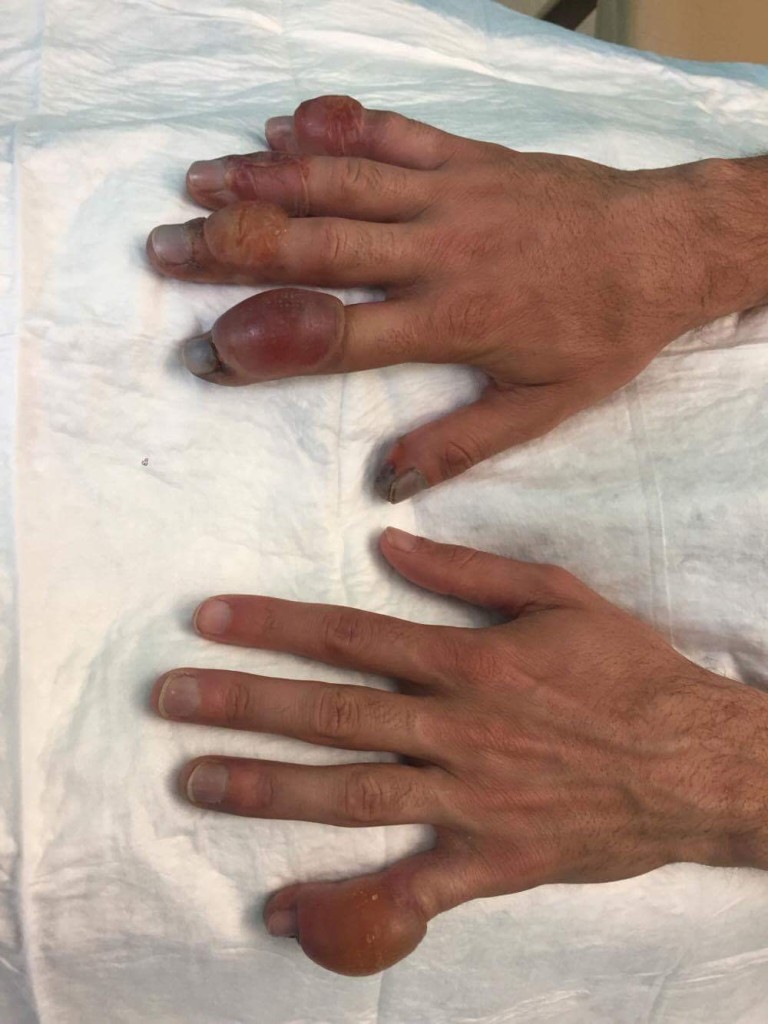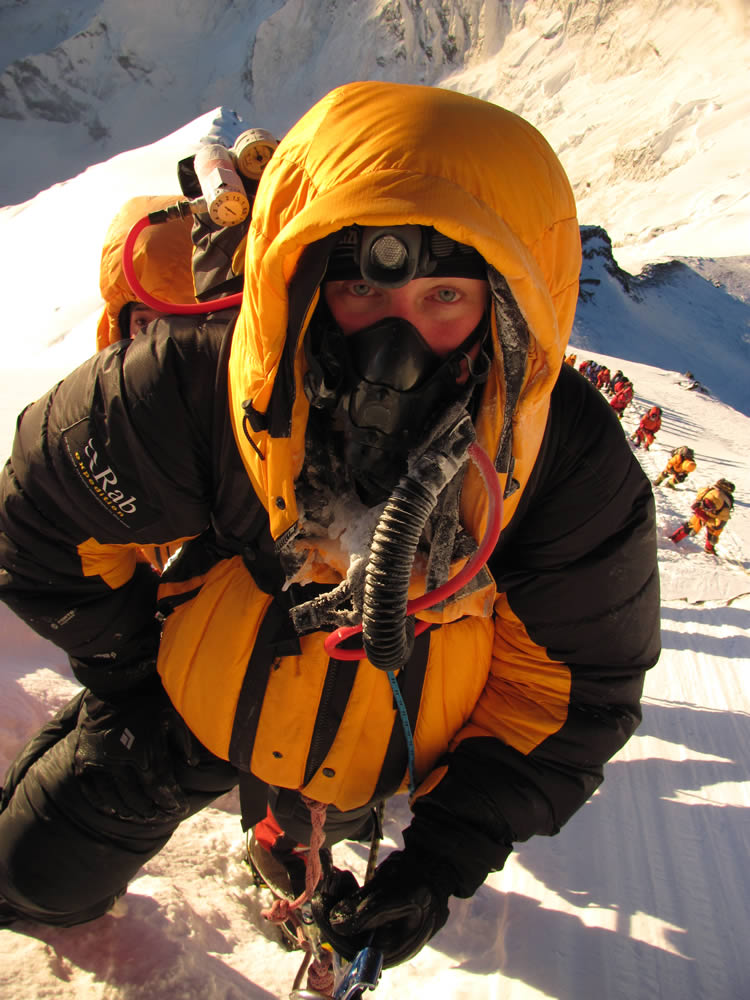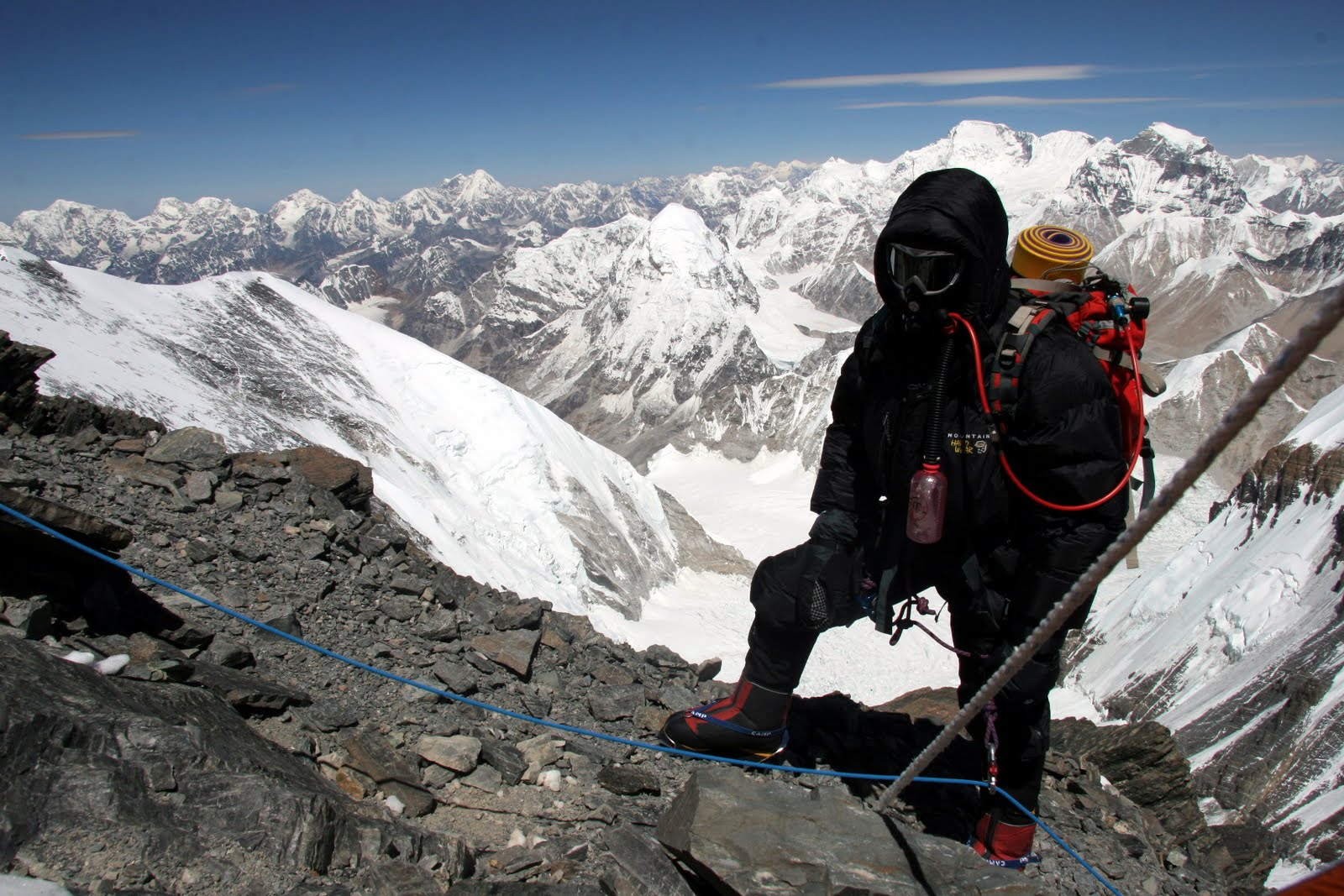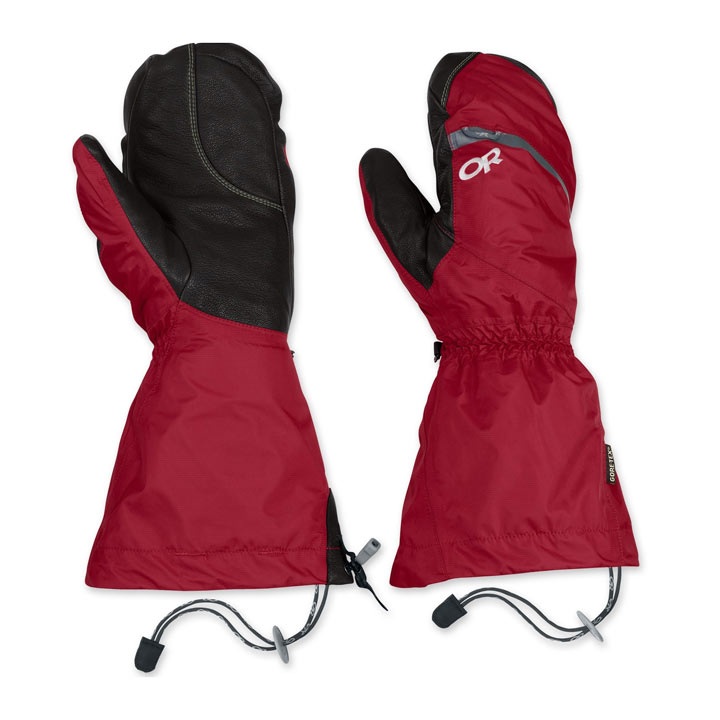Everest
(and other Mountains)
How to stop getting cold hands (and feet)
and how to manage yourself along the way.
Contrary to popular belief frostbite is not just about black, necrotic fingers and toes. It usually starts with a gradual loss of feeling and possible whiteness of the skin … but at this stage it is still a retrievable situation.
It progresses to a more waxy appearance where a longer spell of exposure to the cold has started to damage the outer layers of the skin.
Next up … purple which, if checked, may recover but in the meantime it is a very sensitive situation with damage and infection becoming a real concern. Blisters will form and pain will be, well, painful.
If left unchecked then this will certainly progress to blackened digits which will eventually need to be surgically removed.

We’ve all been there – cold hands that are difficult to rewarm, fumbling gear with useless digits, the hot aches that make grown men and women cry. But is it really necessary? At first it would seem to be ‘the norm’ or part of some kind of apprenticeship because whenever anyone gets the hot aches everyone else seems to nod sagely with a ‘been there mate’ kind of attitude.
The good news is that it probably isn’t necessary at all and may well have a lot to do with your personal organisation rather than whether your gloves are warm enough.
Inconvenience can lead on to a critical situation.
First off I’ll deal with the fact that whilst getting cold hands is a painful inconvenience in Scotland it can be a life threatening condition in terms of Himalayan ultra high altitude mountaineering.
In The Lakes, in summer, if you lose a glove then it is a minor irritation and you can probably just pop your hand in your pocket. In Scottish winter conditions you’re probably going to be carrying some spare gloves and so if you lose a glove then you can pop your rucksack off (or reach in to a jacket pocket) and get your spare gloves out.
On Everest summit day, however, it is a different matter. If you lose a glove then it is literally a life threatening situation and you may as well get out your rosary beads … except that you can’t use them because your hand is cold.
Hierarchy and the rarified atmosphere.
There is a hierarchy within the body and the brain rules the roost. If the brain is not receiving enough oxygen then it will demand it from elsewhere. First off the brain will sacrifice circulation to the extremities – in which case frostbite is a potential problem. If the brain still isn’t getting enough oxygen then it will sacrifice circulation to the torso – in which case hypothermia is a potential problem. If the brain still isn’t receiving enough oxygen then, in due course, it will cease to function properly and the person will lapse in to a coma which, in turn, will lead to death. This doesn’t just happen within minutes but is a slow, insidious process where there is a gradual loss of function. This is true for any extreme weather conditions where the brain is insulted due to the cold.
At altitude there is the added whammy that there is less oxygen – in which case the brain is much more susceptible to the effects of hypoxia (inadequate oxygen supply) and the gradual onset could be a much more marked and sudden occurrence.
Climbing with oxygen at ultra high altitude is not only a way of maintaining brain function but also a way of potentially avoiding getting cold (if the brain has oxygen it won’t sacrifice the circulation to the extremities). Jen above the balcony wearing a balaclava under her down suit with the zip down slightly – her head is warm (enough) but equally she isn’t overheating. By carefully regulating her temperature and her pace to the 2 litre flow of oxygen she is high on Everest wearing a decent pair of gloves Here’s what you can do … o Wear a hat! If you think logically about the hierarchy then one way to avoid getting cold hands (or feet) is to keep the brain warm. What better way than to wear a hat? Blood not only supplies oxygen to the brain (and elsewhere) for it to function but is also provides warmth, so it goes without saying that a hat will allow the brain to retain a degree of warmth and it will then be less dependent on receiving it from elsewhere. To that end it will be less likely to sacrifice circulation to the extremities. Once you have set off if you find that a hat is too warm then replace it with an earwarmer and stow the hat for later, or pop the hat off and use a buff up and over your ears if they are getting cold. Or pull your hood up to keep the breeze off your ears whilst allowing the head to cool off a little. Basically you need to be versatile and flexible with your gear and your methodology. o Wear a warm top! Next in the hierarchy is the torso where the other major vital life giving organs reside – so wear a decent top. If you have a warm (enough) head and a warm (enough) torso then you are much more likely to maintain a decent circulation to the extremities. Having said that, like the head the torso and major organs don’t like to be cooked so you must avoid getting too warm otherwise you are compromising yourself in other ways (more later). If you are going to be walking even at only modest speeds then if you whip off a layer before you start a journey so that you are comfortably cool then you are probably going to be comfortably warm enough in 10 or 15 minutes from the outset. Sometimes even this ploy is difficult to get right when you find yourself walking in to the wind and you’re cooler than anticipated, or the sun pops up and you are warmer than anticipated. In which case do something about it (more later). But the main point here is that you are creating warmth through movement that can then be distributed by the blood to the fingers and toes because your head and your torso are not being cooled and therefore aren’t being compromised. o Avoid sweating. If you get too hot then you will start to sweat – the body’s main cooling mechanism. If you sweat too much then your clothing will wet out and even the best wicky layers will have trouble transporting moisture from your body. When you stop you will have a damp clammy layer against your skin which will start to cool your torso at exactly the same time you have stopped the exertion and the heat production. If you pop a warm layer on straight away then you may be in time to avoid the body cooling further than it ought to. If you have a really wet clammy wicky layer then it may well be prudent to replace it as well as donning a warm outer layer. For the hands and feet if you have created sufficient sweat to wet out your socks and gloves then this can be difficult to address. Wet socks are less efficient than dry ones and used socks are less efficient than clean ones. So it would be prudent on a 5 day summit bid on Everest to take spare, clean (preferably unused) socks to The South Col which are saved specifically for summit day. If you have wet inner boots it is always worth removing the insole to allow any moisture in the boot to have a chance of dispersing. If you don’t remove the insole then the moisture under it can’t escape and at cold temperatures it will then freeze. You’ll be popping not only a cold boot on to your foot but also walking on a frozen insole. Nice! Gloves are sometimes a bit more difficult to deal with if they get really soaked through sweat. If they don’t have removable inners you can’t really turn them inside out that easily and with no access to radiators on the hill it can be difficult to raise the temperature sufficiently to drive the moisture out. Far better to avoid wetting out in the first place by using different gloves for different conditions where appropriate. Carrying spare gloves in jacket pockets makes you much more inclined to change them on the go whereas if they are in a rucksack you are much more likely to make do because you can’t be bothered with the hassle. And regardless of that, warm gloves with removable inners are far superior to those without because they can be dried so much more readily on the hill. o If you are cold (or hot) do something about it! It is important not only for your own comfort, but also for your well-being, to make sure that you don’t over-cook or become too cool. Over-cooking is not only bad for the organs but also causes you to sweat (see above) which, in turn, causes you to become dehydrated. If you are dehydrated you are much more likely to be prone to frostbite, hypothermia, Acute Mountain Sickness, HACE & HAPE and, in extreme cases over a more prolonged period, more susceptible to DVT (Deep Vein Thrombosis) which is a very serious, life threatening problem and is the end of your trip. Learn how to manage yourself on the go. As mentioned earlier start out comfortably cool, have a headband and some mid weight gloves in your pockets so they are accessible and know where all your zippers are. Have water accessible either via a drinking tube or, in colder conditions where a tube will freeze, a water bottle in an insulated carrier clipped to your rucksack. In even colder conditions water can be stowed inside your down suit (half litre bottles work very well for this). Wicky tops with deep chest zips are much more preferable than crew neck versions. A zipped top can be vented whereas a crew neck top has no versatility whatsoever. Trousers or over trousers with thigh zippers are a great way of being able to cool down as well – the thighs generate a lot of heat when you start ascending and leg zippers are yet another way you can regulate your temperature on the go. One thing to remember, however, is that there is a time and a place to be doing up / undoing front zippers, underarm vents, putting hoods up, taking hats off, changing to lighter gloves etc. If you try doing it on the move you may well compromise your safety. Sometimes stopping is not an option (for instance areas of the Khumbu Icefall, below threatening seracs or when in or below avalanche prone terrain) – in which case you either need to pre-empt and stop earlier or keep on going for the time being knowing that you can do something about it in 5 or 10 minutes. Togged up in what were quite cold blowy conditions. By knowing our gear intimately we were able to move high on Everest to get ready for an 18 hour weather window when most other teams were hunkered down at ABC or C1. o Keep hydrated. As mentioned earlier it is vitally important to maintain your fluid levels. On the mountain you will probably go in to deficit (you won’t drink enough, eat enough or sleep enough) and this is fine . but only for so long. Make sure that on any rotations down to Base Camp that you take the time to rest and refuel. And if you remember that fluid is more important than food and food is more important than sleep you will not be far off the mark when you start brewing up instead of dossing around at the next camp (more later). On summit night make sure that you start out with hot water in your bottles and that they are in insulated pouches. If you boiled your water a few hours before setting off it will already have had some time to cool down so, if necessary, reheat it before you start out. Once it freezes (which can happen surprisingly quickly in your journey) it is worse than useless. So start out with hot water and keep drinking little and often. o Keep food going in. Food is fuel and without fuel you’ll compromise yourself. It is important not only to refuel between rotations on the hill but also to make sure that you eat as well as possible when on the mountain. Perversely at altitude you may well go off your food just when you need more calories than ever before. Either which way snacking along the way with treats from your pockets will stop you bonking because if you bonk you are likely to get cold hands and feet. Every time you have a bite to eat you should drink. o The importance of concurrent activity. This can be a great time saver. If you stop to take off a layer then this could be an opportunity to do anything else that you anticipate needing to do in the next 30 minutes at the same time. For instance if you are wanting to remove a layer in The Khumbu Icefall at 07.30 in the morning it may be prudent to apply suncream, pop some lipsalve on, have a quick bite to eat and a drink, take a photo, get your sunglasses out and then, just before you set off again, whip off that layer that you had stopped to remove. That way you aren’t stopping in 25 minutes later when you are suddenly in the sun. In which case you are being more time efficient which means you’ll get to camp earlier and be drinking sooner. Or on arrival at Camp 3 and you’re feeling a bit pooped you could slowly busy yourself by collecting some snow, get the cooker going and then sit down to get your breath back. In 20 minutes when you have sufficiently recovered ‘Hey Presto!’ you have a litre of water ready. o Gloves vs Mitts. Gloves tend to give you greater dexterity whereas mitts tend to be warmer because all your individual sausages are together (comparing like for like). For high altitude / cold environs I would suggest buying warm gloves that are big enough to accommodate a thin liner glove whereas for warmer mitts I’d suggest that they are big enough to take a more substantial powerstretch glove. This then not only gives you plenty of options but also means that if you do need to remove the big outer garment you aren’t having bare fingers in contact with the snow and ice or, more importantly, any metal items. If the glove is not big enough and there is any pressure then are you not only compressing the insulation but you are also likely to compromise your circulation and end up with a cold hand. If you are wearing gloves and they are just not quite up to the job, or you are intermittently getting cold hands along the way, then retracting the fingers from their individual compartments, forming a fist and flexing & unflexing will usually work as an interim measure. With practice you can retract fingers for warmth purposes and still use trekking poles or even an ice axe on easy, walking terrain.


o Boots and socks.
The same goes for boots – better half a size too large than half a size too small. Added to that you may get peripheral oedema (swelling of the feet and / or hands and / or face) at altitude in which case a snug boot would become a BIG problem.
It’s a bit more difficult to invigorate the circulation in the feet but certainly flexing and moving the toes with every step can delay or prevent the onset of cold feet.
Don’t start out with cold boots or they will make your feet cold before your feet make the boots warm. As mentioned earlier fresh socks are a prudent measure and you may as well use foot warm up sachets as standard – better a slightly warm foot than a slightly cold foot.
And, as covered next for the hands, don’t let your feet get cold in the first place by managing yourself carefully before you have to pop your (warm) boots on.
o Don’t let your hands get cold in the first place.
Everything listed above is important and if you manage yourself not only on a daily basis but on a minute by minute basis you will be in a good place. But my number 1 piece of advice is not to let your hands get cold in the first place. You may well be hydrated, wearing a warm hat or balaclava and a nice, big down suit (as recommended by the author), have some hand warm up sachets activated and be hooked up to your oxygen for Everest summit day but it is now vital that you don’t let your hands get cold or your mitts won’t work.
So you pop out of your tent and start donning your crampons. It’s difficult work in the dark with your down mitts on so you remove one of them and pop it inside your suit (if you put it on the floor or in between your teeth then a) it’ll blow away and / or b) it’ll get cold. If you pop it inside your jacket and do the zip up, however, then it is keeping you warm, you are keeping it warm, you won’t lose it and you know where it is).
So you’ve removed one of your mitts and you’re down to powerstretch gloves. You now have better dexterity but you are in a race against time before you compromise yourself. If your hand gets cold then vasoconstriction (narrowing of the blood vessels) will start to occur in the wrist and the circulation to your hand will be compromised. If you continue doing the crampon up (it will only take another 15 seconds) then you will find that your hand is less dextrous, you will undoubtedly fumble your actions, your hand will get colder, you’ll fumble more and 45 seconds later you have a very cold hand.
An unused mitt is not a warm mitt – it is a mitt that has potential to be warm. To be warm it needs a heat supply and you have just cut that heat off by letting your hand get cold. Combined with the lack of oxygen at altitude which impairs your circulation (see notes above about hierarchy, hypoxia and brain function) you have a double whammy of having a cold hand and no way of invigorating the circulation. Wave your hands around all you want – at The South Col you’ll just get out of breath.
So let’s go back to putting our crampon on. You feel your hand starting to get cold (only 15 seconds to go until the crampon is on) – AND STOP. Get your mitt on before your hand gets any colder and start flexing / unflexing the fingers. Stay where you are as your crampon is only 2/3rds done up but by maintaining the circulation to your hand rather than having it cut off at least you haven’t got a cold hand. Once you are satisfied that you have rewarmed your hand enough then remove the mitt, pop it inside your jacket, do the zip up (or it will drop out when you bend over) and continue with the task at hand (so to speak) of attaching your crampon. Now it will only take another 15 seconds and you can start on the second crampon.
And repeat as necessary.
By not letting your hand(s) get cold in the first place you have avoided getting a critically cold hand. I’m sure that you can well imagine that starting out on Everest summit day with a cold hand in a cold mitt would not be a great start to what is a serious day.
Equally when you stop at The Balcony and are changing your oxygen cylinder it is crucial that you manage yourself accordingly.
o Don’t lose your glove or mitt.
Drop a mitt at The South Summit because you were taking a photo and by the time you have taken your rucksack off and extracted yourself from your oxygen supply you will have a frozen, useless hand.
Get a cold hand here and it is a life threatening situation. If you can’t operate equipment properly because you are fumbling your gear then, as mentioned earlier, you may as well get out your rosary beads.
Every change over at rebelays will become ever harder because you have lost dexterity and you will be slower as a result. You’ll be much more likely to drop a piece of gear which will slow you down further still . and you’ll be eating in to your precious oxygen supply. Run out of oxygen and it’s game over. You will very quickly become increasingly hypoxic, the brain will demand even more oxygen, the extremities will become colder followed by the torso. It’s not a rosey outlook.
And all because you dropped a glove.
In summary:
• Be acquainted with the mountain environment so that drinking, eating and managing yourself on the go are all second nature
• Be acquainted with your gear before you come to Everest (or any big hill) so that if there are any limitations you have discovered you can adapt your gear or how you manage yourself accordingly. For instance zippers may need extending so that you can operate them with big mitts on
• Keep warm, but not too warm
• Vent off where necessary so you don’t overheat
• Stay well fed and hydrated
• Know how to use your oxygen system and how to calculate how long it will last according to the flow
• Avoid cold hands and feet by not letting them get cold in the first place
• Don’t, under any circumstances, drop a glove or mitt – you will live to regret it … but possibly not for very long.
• PLEASE REMEMBER that, generally speaking, frostbite is a self inflicted injury and often avoidable.
I hope that you find this article useful and if you have any comments or advice they will be very gratefully received.
Yours – Tim Mosedale

